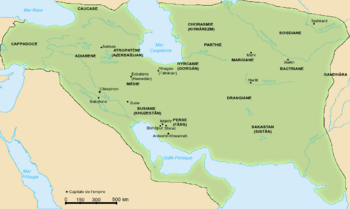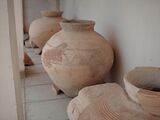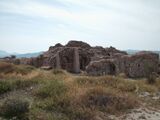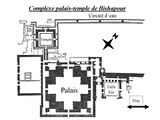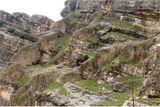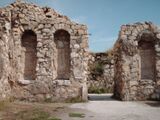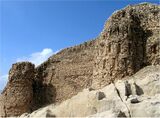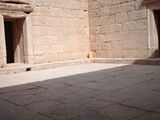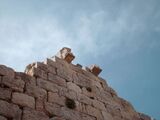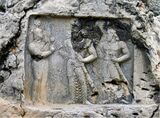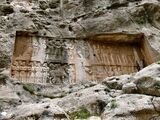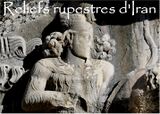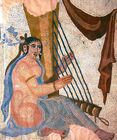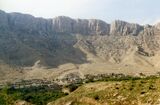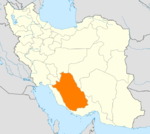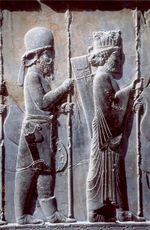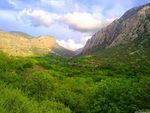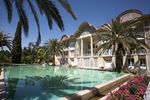بیشاپور
بالفارسية: بیشاپور | |
 The ruins of Bishapur | |
| الاسم البديل | Bishâpûr |
|---|---|
| المكان | كازرون، محافظة فارس، إيران |
| الإحداثيات | 29°46′40″N 51°34′15″E / 29.77778°N 51.57083°E |
| النوع | مستوطنة |
| التاريخ | |
| الباني | شاپور الأول |
| تأسس | 226 م |
| الثقافات | الفارسية (العصر الساساني) |
بيشاپور ( Bishapur ؛ الفارسية الوسيطة: Bay-Šāpūr؛ فارسية: بیشاپور) كانت مدينة قديمة في فارس الساسانية (إيران) على الطريق القديم بين پرسيس و عيلام. الطريق ربطت العواصم الساسانية اصطخر (القريبة جداً من پرسپوليس) و قطسيفون. It is located south of modern Faliyan في مقاطعة كازرون في محافظة فارس، إيران. Bishapur was built near a river crossing and at the same site there is also a fort with rock-cut reservoirs and a river valley with six Sassanid rock reliefs.
. . . . . . . . . . . . . . . . . . . . . . . . . . . . . . . . . . . . . . . . . . . . . . . . . . . . . . . . . . . . . . . . . . . . . . . . . . . . . . . . . . . . . . . . . . . . . . . . . . . . . . . . . . . . . . . . . . . . . . . . . . . . . . . . . . . . . . . . . . . . . . . . . . . . . . . . . . . . . . . . . . . . . . . .
التاريخ
الاسم بيشاپور مشتق من Bay-Šāpūr, which means Lord Shapur.[1]
According to an inscription, the city itself was founded in 266 AD by Shapur I (241-272), who was the second Sassanid king and inflicted a triple defeat on the Romans, having killed Gordian III, captured Valerian and forced Philip the Arab to surrender. The city was not a completely new settlement: archaeologists have found remains from the Parthian and Elamite ages. The city remained important until the Arab conquest of Persia the rise of Islam in the second quarter of the 7th century AD.
The city has a rectangular plan with a grid pattern of regular intra urban streets, resembling Roman city design. This design was never repeated in the architecture of Iran.[2]
الحفريات والأبحاث
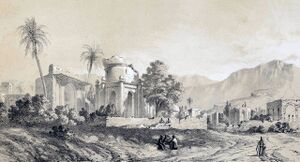
The site was cleared by the Russian-French archaeologist Roman Ghirshman in the 1930s. The British archaeologist Georgina Herrmann has also written a book about the Sasanian rock reliefs in Bishapur which was published in 1980.[3]
الزينة
The main part of the excavations took place in the royal sector, in the east of the city. A water temple, interpreted as an معبد أناهيتا، نُصِب بالقرب من القصر.
The floor was paved with black marble slabs, with a mosaic border. At the top of each alcove there was a picture of women naked under their transparent veils: courtesans, musicians, dancers, women twisting garlands, together with a few richly attired noble ladies.
Sasanian era floor pavement marble mosaic excavated by Roman Ghirshman, c. 1939–1941. وحالياً موجود في اللوڤر
Persian-Roman floor mosaic detail from the palace of Shapur I at Bishapur. Presently housed in the المتحف الوطني في إيران
انظر أيضاً
المراجع
- ^ "Welcome to Encyclopaedia Iranica".
- ^ Salma, K. Jayyusi; Holod, Renata; Petruccioli, Attilio; André, Raymond (2008). The City in the Islamic World. Leiden: Brill. p. 174. ISBN 9789004162402.
- ^ http://www.worldcat.org/title/sasanian-rock-reliefs-at-bishapur-part-1-bishapur-iii-triumph-attributed-to-shapur-i/oclc/59815517&referer=brief_results قالب:Bare URL inline
وصلات خارجية
- Bishapur; Photos
- Bishapur, Photos from Iran, Livius Archived 2016-11-10 at the Wayback Machine.
- City of Bishapur (Video)
- Pages using gadget WikiMiniAtlas
- Short description with empty Wikidata description
- Coordinates not on Wikidata
- Pages using infobox ancient site with unknown parameters
- Articles containing فارسية-language text
- Articles with hatnote templates targeting a nonexistent page
- مباني ومنشآت اكتملت في القرن الثالث
- Architecture in Iran
- Roman Empire art
- مدن ساسانية
- مباني ومنشآت في محافظة فارس
- أماكن مأهولة سابقاً في إيران
- مقاطعة كازرون
- جغرافيا محافظة فارس
- Tourist attractions in Fars Province
- Stone buildings
- شاپور الأول

